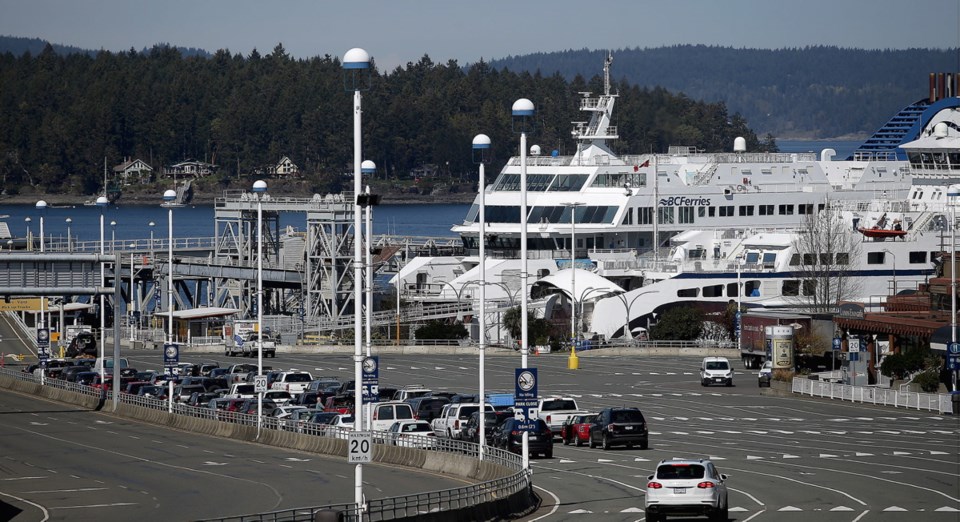B.C. Ferries is struggling to stay afloat financially after the federal government failed to include the company in bailout funding for public transit agencies during the pandemic.
The ferry corporation said it is racking up debt as it absorbs steep losses due to ridership and revenue declines caused by reduced travel in recent months. B.C. Ferries has lost $130 million in revenue since the start of the pandemic in March, and its financial situation remains dire, CEO Mark Collins said in an interview.
“We’ve approached this from an operational and financial sustainability perspective that we must chart a path all on our own,” said Collins. “We must find a way out of this on our own. We must assume that no help is coming.”
Premier John Horgan said he continues to lobby Deputy Prime Minister Chrystia Freeland to get B.C. Ferries eligible for the federal funds announced July 16.
B.C. Transit and TransLink are set to receive $560 million, which will be matched by the B.C. government, to cover operational losses caused by ridership declines during the pandemic. But B.C. Ferries, which also had to shut down entire routes and sharply curtail service, is so far excluded.
“Minister Freeland and I have talked at length about the importance of B.C. Ferries to B.C. coastal communities [that] absolutely depend on our marine highway,” said Horgan. “She understands that, and we’re working on mechanisms to allow us to access those federal dollars. We’re not done on that yet.”
The federal government said it is still negotiating with premiers about what unique regional public transportation systems could be included in the federal funds.
“We also know that Canada is a highly diverse country and that each province and territory has its own regional needs,” said Freeland’s press secretary Katherine Cuplinskas.
“That is why we look forward to continue working with all of Canada’s premiers, including Premier Horgan, on the ways in which these investments can help Canadians and businesses from coast to coast weather this global health and economic crisis.”
B.C. Ferries service was reduced dramatically during the peak of the pandemic when only essential travel was recommended, and the ferry corporation for a time eliminated the Departure Bay to Horseshoe Bay route entirely.
“When ridership is down, traffic is down, and no help is in sight, you do what you have to do in order to carry on,” said Collins. “So that’s been our philosophy and remains our philosophy today.”
During the worst of the pandemic, when traffic had dropped 80 per cent compared to last year, B.C. Ferries lost as much as $1.5 million a day in revenue, said Collins. That was trimmed to $1.2 million a day after cutbacks and cost reductions, said Collins.
As the economy reopens, traffic has rebounded to between 25 to 30 per cent lower than last year, said Collins. Yet B.C. Ferries is still losing as much as $800,000 a day in revenue, which after internal cutbacks translates into a $400,000 net loss per day, he said.
“So that’s an improvement,” said Collins. “But still a pretty dire situation.”
B.C. Ferries had been forecasting a $300-million net loss this fiscal year, but is now expecting that number to be about $150 million, said Collins. It expects traffic next year to be down 10 per cent from 2019 levels. “By the summer of 2022 we will probably be back to where we were in 2019.”
B.C. Ferries can’t raise its rates without permission from the independent ferry commissioner, and it can’t cut any more routes because all the discretionary sailings have been eliminated and what is left are core service levels mandated in a contract with the government, said Collins.
‘We’re taking on debt to get through the pandemic.”
The result of rising debt will be delays or cancellations in planned upgrades to ferry terminals and the purchase of new ships. “One way that in the long term we reduce the cost of the ferry system is we could spend less on new or rebuilt terminals and new ships,” he said. “Of course, that catches up with you. ...
“But we could limit our capital spending over the next few years, and we’ve had these discussions with our board of directors and others of radically limiting capital spending. That’s not always a popular decision because people are looking forward to their rebuilt and revitalized ferry system. But if we can’t afford it, we can’t afford it.”
Terminal upgrades at Horseshoe Bay and Langdale are now on hold, he said. Five ships currently under construction will continue because contracts are already in place, but an $800-million project for a new phase of ships is indefinitely delayed, said Collins.
“It’s our hope that any support that may come our way would be sufficient to enable us to continue those investments,” he said.
If B.C. Ferries doesn’t receive any financial help, the effects of its financial challenges may not be seen for as long as two years. That is when negotiations begin for the next six-year contract between the province and B.C. Ferries on routes and service levels, and when the ferry corporation can apply for fare increases to begin to recoup its losses.
The ferry company could also make an extraordinary filing to the independent ferry commissioner to raise rates to recover costs in an emergency.
“The commissioner would be obliged to consider, but he wouldn’t be obliged to grant it,” said Collins.
“We know that nobody likes a fare increase. But, you know, we’re in a constrained environment here, and rather than have the system go bankrupt or services being cut, then perhaps that’s the option that would be granted.”
ROB SHAW
Vancouver Sun



